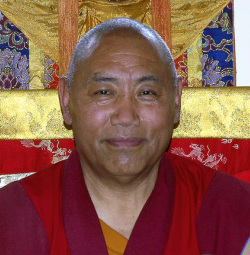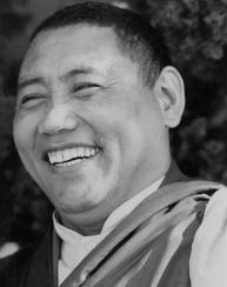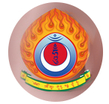Khenchen Konchog Gyaltsen Rinpoche
Visiting Teacher
|
The village of Tsari and the surrounding areas are among the most sacred places in Tibet. It was there that the most Venerable Khenchen Konchog Gyaltsen Rinpoche was born in the spring of 1946, and it was there that he spent his early years. In 1959, because of the political situation in Tibet, Khenpo Rinpoche fled to India with his family. The family then settled in Darjeeling, where Rinpoche began his education. Even at a young age, he was an excellent and dedicated student, and was able to complete his middle school studies in less than the average time. At about this same time, a new university, the Central Institute of Higher Tibetan Studies, opened in Varanasi, India. Determined to be among its first students, Khenchen Rinpoche traveled to Varanasi in October 1967 to seek admission. He then began a nine-year course of study that included Madhyamika, Abhidharma, Vinaya, the Abhisamayalankara, and the Uttaratantra, as well as history, logic, and Tibetan grammar. In early 1968, he had the good fortune to take full monastic ordination from the great Kalu Rinpoche and, shortly after graduating from the Institute, he received teachings from the 16th Gyalwa Karmapa on The Eight Treasures of Mahamudra Songs, by the Indian mahasiddhas.
|
Even after completing this long and arduous course of study, Khenchen Rinpoche wanted only to deepen his knowledge and practice of the Dharma. With the same intensity that he brought to his earlier studies, Rinpoche sought out and received teachings and instructions from great Buddhist masters. One was the Venerable Khunu Lama Rinpoche, with whom Khenchen Rinpoche studied two works of Gampopa The Jewel Ornament of Liberation and The Precious Garland of the Excellent Path. Rinpoche's studies with the Venerable Khunu Lama also included Mahamudra and many of the songs of Milarepa.
In all his studies, The Jewel Ornament of Liberation is one of the texts that Khenpo found to be most inspiring. Lord Gampopa lays out the teachings in a clear and systematic way that is understandable to beginners. At the same time, the work is of such profound depth that scholars and practitioners can study it over and over and still not fully grasp its meaning. He has said on several occasions, "Anyone who knows the Jewel Ornament well can say that they really understand Buddhism."
Maintaining a balance between theoretical understanding and the practice of meditation, Khenpo Rinpoche began a three-year retreat in 1978 under the guidance of the enlightened master Khyunga Rinpoche. During this time, he was able to deepen and enhance his understanding of The Five-fold Path of Mahamudra and the profound Gong Chik text of Lord Jigten Sumgon. He also received many other transmissions.
In 1985, Khenchen Rinpoche traveled to the main seat of the Drikung Kagyu lineage, Drikung Thel, in Tibet. There, he was able to receive personal blessings, as well as instructions and transmissions of Mahamudra and the Six Yogas of Naropa, from the enlightened master Venerable Pachung Rinpoche.
In 1982, the force of karma and the requests of many practitioners combined to bring Khenchen Rinpoche to the United States. By late 1983, the Tibetan Meditation Center was well established in Washington, DC. Their original location was the site of innumerable teachings, practices, retreats and ceremonies. In September 1984, and again in 1987, the young Center was blessed with personal visits and teachings by His Holiness the Dalai Lama. Through Khenchen Rinpoche's and the Center's efforts, Drikung Kyabgon Chetsang Rinpoche visited later in 1987, and people in several states were able to receive benefit from his teachings and presence.
Wanting the teachings of Dharma to reach as many people as possible, Khenchen Rinpoche has quickly adapted himself to Western forms of communication. He has made appearances on television, been a guest on many radio programs, lectured extensively at colleges and universities, and spoken to the public through countless newspaper articles. Between 1983 and 1990, Khenchen Rinpoche singlehandedly translated critical Drikung Kagyu practices, prayers and histories into English. The originals of the texts were all written out by his hand: Achi Chokyi Drolma, Amitabha, Bodhicitta, Chakrasamvara, Chod, the complete Ngondro, Five-fold Mahamudra, Four-Session Guru Yoga, Green Tara, Lama Chopa and tsok, Mahakala, Mandala offering, Manjushri, Medicine Buddha, Milarepa Guru Yoga, Nyung Ne, Peaceful Guru Padmasambhava, Phowa, Refuge, Chenrezig, Vajrapani, Vajrasattva, Vajrayogini, and White Tara. The Illusory Body teachings, Supplication to Tara, Treasury of Benefit and Happiness, Meaningful to Behold, many other prayers and three of his four books were all translated and published during this time. This priceless work formed the essential base from which the holy Dharma could be taught and practiced.
For different reasons, Khenchen Rinpoche and the Tibetan Meditation Center moved to Frederick, Maryland in November 1991. Nestled inside a state park, the Center is now situated on four wooded acres. A small temple has been built there, and was consecrated by His Holiness Chetsang Rinpoche in 1994. With this larger facility and in surroundings more conducive to contemplation, Rinpoche has been able to benefit even more people with his teachings. Now that Western students are becoming interested in long term retreat practice, plans are being made to establish a residential retreat center nearby.
In more recent years, Khenchen Rinpoche spends a great deal of his time traveling in order to give teachings and lead retreats. He has established centers throughout the US and in Chile, and he frequently visits in Europe, especially Germany and Austria, as well as Southeast Asia. Last year, he taught the Gong Chik to the monks and nuns at the Drikung Kagyu Institute in Dehra Dun, India. With the financial assistance of the Tibetan Meditation Center's Text Project, Rinpoche arranged for 1,200 copies of the text to be printed, and then distributed them to monks, nuns and monasteries in India, Nepal and Tibet.
Rinpoche consistently strives to make important texts available to the public and to provide his students with thorough and systematic training in the Dharma. A skilled and dedicated translator, he has published four books before this one—Prayer Flags is a small book which contains brief life stories of Gampopa, Phagmo Drupa and Lord Jigten Sumgon, as well as some Dharma-realization songs by lineage masters. There are some short teachings on the stages of Mahamudra practice, and condensed instruction on how to carry the experiences of sickness and death into one's practice.
The Garland of Mahamudra Practices is very helpful for those who already have a little understanding of the Dharma. It contains a description of all the Ngondro practices: the four foundation thoughts (precious human life, awareness of impermanence, karma and the suffering of samsara), the four extraordinary preliminary practices (refuge, Vajrasattva, mandala offering, and Guru Yoga), yidam practice, special guru yoga and a mahamudra session itself. The mahamudra section a little more detailed, but still quite condensed. There are basically two points—establishing the view of mahamudra and then how to practice it.
In Search of the Stainless Ambrosia is good for beginners and more advanced practitioners. First, it summarizes the fundamental teachings of refuge, love and compassion, and the six paramitas. Then, there are short sections on mahamudra and yidam practices, the experience of dying, an explanation of Chod practice and some Phowa teachings.
The Great Kagyu Masters is a translation of a 13th Century text which puts the life stories of the great masters together in one volume. It is very helpful to practitioners to have these accounts available for inspiration and guidance.
Two other books are in production and will be released soon. One is a Handbook for Practitioners, which is designed for study by individuals or groups without ready access to a lama. The second one is a translation of A Hundred Verses of Advice, a profound yet accessible teaching written by Drikung Dharmakirti.
In each case, Rinpoche has taken enormous care to make the translations as precise as possible. Because he himself has been so moved by these words that come directly from great masters, he believes it is critical that these same words be presented in an unadulterated manner. For example, to translate this text, he and his editor went through the entire text word by word four times, sometimes spending an hour or more on a single phrase or sentence. It is his sincere hope that, through this painstaking effort, many others will be as inspired as he was by these precious Dharma teachings.
Remembering the struggles of his early years, Khenchen Rinpoche inspires and supports monks, nuns and lay people in their practice of the Dharma and is always ready to assist them in whatever way he can. To all, he gives of himself freely. With his heart and mind turned firmly toward the Dharma, he compassionately and patiently shows the path.




